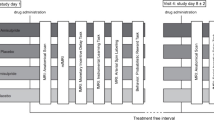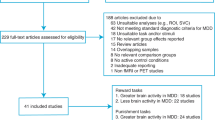Abstract
Depression is a debilitating psychiatric disorder characterized among other aspects by the inability to properly experience or respond to reward. However, it remains unclear whether patients with depression present impaired reward system due to abnormal modulatory mechanisms. We investigated the activation of the nucleus accumbens (NAcc), a crucial region involved in reward processing, with functional magnetic resonance imaging using the desire-reason-dilemma paradigm. This task allows tracking the activity of the NAcc during the acceptance or the rejection of previously conditioned reward stimuli. Patients were assigned into subgroups of lower (LA) or higher (HA) NAcc activation according to beta weights. LA patients presented significant hypoactivation in the ventral tegmental area in addition to bilateral ventral striatum, confirming impairments in the bottom-up input to the NAcc. Conversely, HA patients presented significant hyperactivation in prefrontal areas such as the rostral anterior cingulate cortex and the anterior ventral prefrontal cortex in addition to bilateral ventral striatum, suggesting disturbances in the top-down regulation of the NAcc. Demographic and clinical differences explaining the abnormal co-activations of midbrain and prefrontal regions were not identified. Therefore, we provide evidence for dysfunctional bottom-up processing in one potential neurobiological subtype of depression (LA) and dysfunctional top-down modulation in another subtype (HA). We suggest that the midbrain and prefrontal regions are more specific pathophysiological substrates for each depression subtype. Above all, our results encourage the segregation of patients by similar dysfunctional mechanisms of the dopaminergic system, which would finally contribute to disentangle more specific pathogeneses and guide the development of more personalized targets for future therapies.



Similar content being viewed by others
Abbreviations
- AD:
-
Antidepressant
- DC:
-
Desire Context
- HA:
-
High NAcc Activity
- LA:
-
Low NAcc Activity
- OFC:
-
Orbitofrontal Cortex
- NAcc:
-
Nucleus Accumbens
- rACC:
-
Rostral Anterior Cingulate Cortex
- RC:
-
Reason Context
- VTA:
-
Ventral Tegmental Area
References
Haber SN, Knutson B (2010) The reward circuit: linking primate anatomy and human imaging. Neuropsychopharmacology 35(1):4–26
Sesack SR, Grace AA (2010) Cortico-Basal Ganglia reward network: microcircuitry. Neuropsychopharmacology 35(1):27–47
Savitz J, Drevets WC (2009) Bipolar and major depressive disorder: neuroimaging the developmental-degenerative divide. Neurosci Biobehav Rev 33(5):699–771
Elliott R, Friston KJ, Dolan RJ (2000) Dissociable neural responses in human reward systems. J Neurosci 20(16):6159–6165
Galvan A, Hare TA, Davidson M, Spicer J, Glover G, Casey BJ (2005) The role of ventral frontostriatal circuitry in reward-based learning in humans. J Neurosci 25(38):8650–8656
Wrase J, Kahnt T, Schlagenhauf F, Beck A, Cohen MX, Knutson B et al (2007) Different neural systems adjust motor behavior in response to reward and punishment. Neuroimage 36(4):1253–1262
Yacubian J, Glascher J, Schroeder K, Sommer T, Braus DF, Buchel C (2006) Dissociable systems for gain- and loss-related value predictions and errors of prediction in the human brain. J Neurosci 26(37):9530–9537
Akitsuki Y, Sugiura M, Watanabe J, Yamashita K, Sassa Y, Awata S et al (2003) Context-dependent cortical activation in response to financial reward and penalty: an event-related fMRI study. Neuroimage 19(4):1674–1685
Nieuwenhuis S, Heslenfeld DJ, von Geusau NJA, Mars RB, Holroyd CB, Yeung N (2005) Activity in human reward-sensitive brain areas is strongly context dependent. Neuroimage 25(4):1302–1309
Pizzagalli DA, Holmes AJ, Dillon DG, Goetz EL, Birk JL, Bogdan R et al (2009) Reduced caudate and nucleus accumbens response to rewards in unmedicated individuals with major depressive disorder. Am J Psychiatr 166(6):702–710
Robinson OJ, Cools R, Carlisi CO, Sahakian BJ, Drevets WC (2012) Ventral striatum response during reward and punishment reversal learning in unmedicated major depressive disorder. Am J Psychiatr 169(2):152–159
Steele JD, Kumar P, Ebmeier KP (2007) Blunted response to feedback information in depressive illness. Brain 130:2367–2374
Knutson B, Bhanji JP, Cooney RE, Atlas LY, Gotlib IH (2008) Neural responses to monetary incentives in major depression. Biol Psychiatry 63(7):686–692
Mitterschiffthaler MT, Kumari V, Malhi GS, Brown RG, Giampietro VP, Brammer MJ et al (2003) Neural response to pleasant stimuli in anhedonia: an fMRI study. NeuroReport 14(2):177–182
Diekhof EK, Gruber O (2010) When desire collides with reason: functional interactions between anteroventral prefrontal cortex and nucleus accumbens underlie the human ability to resist impulsive desires. J Neurosci 30(4):1488–1493
Diekhof EK, Nerenberg L, Falkai P, Dechent P, Baudewig J, Gruber O (2011) Impulsive personality and the ability to resist immediate reward: an fMRI study examining interindividual differences in the neural mechanisms underlying self-control. Hum Brain Mapp 33(12):2768–2784
Diekhof EK, Keil M, Obst K, Henseler I, Dechent P, Falkai P, Gruber O (2012) A functional neuroimaging study assessing gender differences in the neural mechanisms underlying the ability to resist impulsive desires. Brain Res 1473:63–77
Cardoso de Almeida JR, Phillips ML (2013) Distinguishing between unipolar depression and bipolar depression: current and future clinical and neuroimaging perspectives. Biol Psychiatry 73(2):111–118
Ghaemi SN, Vohringer PA (2011) The heterogeneity of depression: an old debate renewed. Acta Psychiatr Scand 124(6):497
Østergaard SD, Jensen SOW, Bech P (2011) The heterogeneity of the depressive syndrome: when numbers get serious. Acta Psychiatr Scand 124(6):495–496
Sanacora G, Gueorguieva R, Epperson CN, Wu YT, Appel M, Rothman DL et al (2004) Subtype-specific alterations of gamma-aminobutyric acid and glutamate in patients with major depression. Arch Gen Psychiatry 61(7):705–713
Drevets WC, Price JL, Bardgett ME, Reich T, Todd RD, Raichle ME (2002) Glucose metabolism in the amygdala in depression: relationship to diagnostic subtype and plasma cortisol levels. Pharmacol Biochem Behav 71(3):431–447
Fountoulakis KN, Iacovides A, Gerasimou G, Fotiou F, Ioannidou C, Bascialla F et al (2004) The relationship of regional cerebral blood flow with subtypes of major depression. Prog Neuro Psychopharmacol Biol Psychiatry 28(3):537–546
Farabaugh AH, Mischoulon D, Fava M, Green C, Guyker W, Alpert J (2004) The potential relationship between levels of perceived stress and subtypes of major depressive disorder (MDD). Acta Psychiatr Scand 110(6):465–470
Stoy M, Schlagenhauf F, Sterzer P, Bermpohl F, Hagele C, Suchotzki K et al (2012) Hyporeactivity of ventral striatum towards incentive stimuli in unmedicated depressed patients normalizes after treatment with escitalopram. J Psychopharmacol 26(5):677–688
Heller AS, Johnstone T, Light SN, Peterson MJ, Kolden GG, Kalin NH et al (2013) Relationships between changes in sustained fronto-striatal connectivity and positive affect in major depression resulting from antidepressant treatment. Am J Psychiatr 170(2):197–206
McCabe C, Cowen PJ, Harmer CJ (2009) Neural representation of reward in recovered depressed patients. Psychopharmacology 205(4):667–677
Gotlib IH, Hamilton JP, Cooney RE, Singh MK, Henry ML, Joormann J (2010) Neural processing of reward and loss in girls at risk for major depression. Arch Gen Psychiatry 67(4):380–387
Fagiolini A, Kupfer DJ (2003) Is treatment-resistant depression a unique subtype of depression? Biol Psychiatry 53(8):640–648
Gaynes BN (2009) Identifying difficult-to-treat depression: differential diagnosis, subtypes, and comorbidities. J Clin Psychiatry 70:10–15
Mayberg HS, Lozano AM, Voon V, McNeely HE, Seminowicz D, Hamani C, Schwalb JM, Kennedy S (2005) Deep brain stimulation for treatment-resistant depression. Neuron 3(45):651–660
Pizzagalli DA (2011) Frontocingulate dysfunction in depression: toward biomarkers of treatment response. Neuropsychopharmacology 36(1):183–206
Schlaepfer TE, Cohen MX, Frick C, Kosel M, Brodesser D, Axmacher N et al (2008) Deep brain stimulation to reward circuitry alleviates anhedonia in refractory major depression. Neuropsychopharmacology 33(2):368–377
Johnstone T, van Reekum CM, Urry HL, Kalin NH, Davidson RJ (2007) Failure to regulate: counterproductive recruitment of top-down prefrontal-subcortical circuitry in major depression. J Neurosci 27(33):8877–8884
Acknowledgments
We acknowledge our colleague Bernd Kraemer for constant support and all MR technicians for competent imaging acquisition. We are very grateful to our participants
Conflict of interest
The authors report no biomedical relationships with financial or commercial interests and identify no potential conflicts of interest.
Author information
Authors and Affiliations
Corresponding author
Electronic supplementary material
Below is the link to the electronic supplementary material.
406_2014_552_MOESM1_ESM.tif
Supplement 1. Small volumes created and displayed with Marsbar as described in the Methods section of the main text (TIFF 358 kb)
406_2014_552_MOESM2_ESM.tif
Supplement 2. Group differences between patients and controls (A) Results from the design matrix and contrast given supporting the heterogeneity in functional activation of the nucleus accumbens (NAcc) as presented in the main text; (B) Illustration of the results of a separate hypothesis of main effect of depression as an entire sample, which we did not set out to test a priori, with design matrix and contrast accordingly given; Note the absence of activation at NAcc with p<0.005 uncorrected (TIFF 218 kb)
Rights and permissions
About this article
Cite this article
Goya-Maldonado, R., Weber, K., Trost, S. et al. Dissociating pathomechanisms of depression with fMRI: bottom-up or top-down dysfunctions of the reward system. Eur Arch Psychiatry Clin Neurosci 265, 57–66 (2015). https://doi.org/10.1007/s00406-014-0552-2
Received:
Accepted:
Published:
Issue Date:
DOI: https://doi.org/10.1007/s00406-014-0552-2




